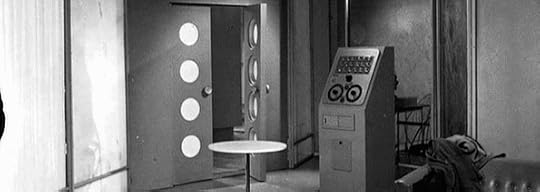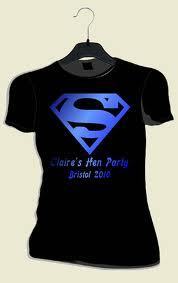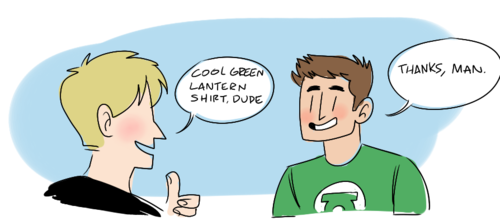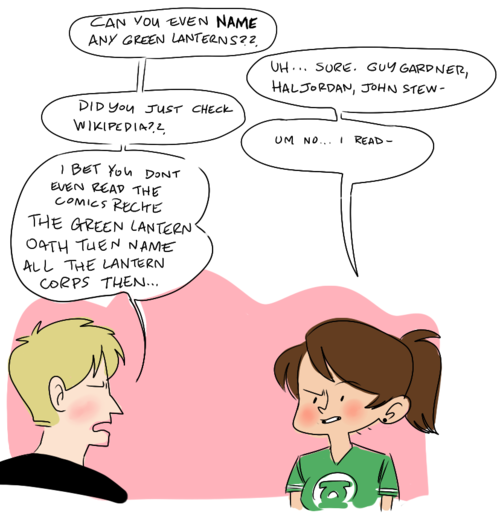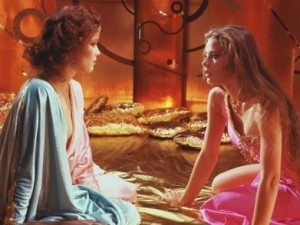Tansy Rayner Roberts's Blog, page 96
November 19, 2012
Barbara Wright at the Brink [WHO-50 —1964]
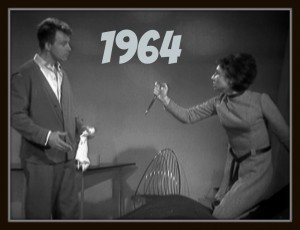 This feels like a major confession, but I haven’t actually seen all of Doctor Who. I tend to forget this, because I have seen, heard or read MOST of the stories, and don’t always remember which ones I have properly watched, and which I have merely imagined thanks to the old Programme Guide I kept close to my heart in the 1980’s.
This feels like a major confession, but I haven’t actually seen all of Doctor Who. I tend to forget this, because I have seen, heard or read MOST of the stories, and don’t always remember which ones I have properly watched, and which I have merely imagined thanks to the old Programme Guide I kept close to my heart in the 1980’s.
Edge of Destruction is one of these – a surreal two parter set entirely in the TARDIS, in which the crew and/or the ship slowly go nuts. I had heard all about this story, read about the narrative beats and notable features many times over, and it never occurred to me that it wasn’t one of the missing ones until it was released on DVD some years back, in a box set with An Unearthly Child and The Daleks.
I still didn’t watch it. I meant to, but never got around to getting that particular DVD. And while my library is awesome at Doctor Who DVDs, I never order them because if I watch it, surely I’ll never get around to buying it!
More recently I discovered a bunch of Hartnells available on BBC iPlayer, and since I was trying to justify my subscription anyway, woohoo! Time to inhale some grainy black and white goodness.
“The Edge of Destruction,” which has also been referred to as “Inside the Spaceship” and “Beyond the Sun,” is the third story of the first season of Doctor Who, released early in 1964, straight after The Daleks. It’s only two episodes long, takes place entirely in the TARDIS set, and as a bonus shows us lots of extra bits of that set, including the complex food machine, a medical centre, doors and corridor, and even references to the vast wardrobe.
Doctor Who in these early days went episode by episode, so viewers would never know how long a “story” would take – there were no story titles (except behind the scenes in production notes, as stories generally made up production blocks), but each episode had its own title much like the stories today.
Already, at this early stage, they were messing with their own formula. We’d had one episode in contemporary London, three with the cave men, and seven on Skaro with the Daleks. The twelfth and thirteenth episodes (making up the entire first run that had been originally commissioned) were quite obviously a money saver. Good old bottle episodes!
It’s ironic that now in the 21st century, with fans longing to see more internals of the TARDIS, it’s actually been deemed too expensive to do so before now – all the little charity minisodes tend to take place in the current Matt Smith console room because it’s a standing set, but scenes taking place in other parts of the TARDIS are exceedingly rare – though they did keep that bit of corridor from The Doctor’s Wife, didn’t they? Didn’t they?
(actually it has been strongly hinted we’ll get to see some serious TARDIS real estate in the second half of season 7, I do hope this is true!)
“The Edge of Destruction” and “the Brink of Disaster” are basically an excuse to let the regular TARDIS crew throw all their resentments and suspicions at each other and work through the issues, so they can go forward without all the “you kidnapped us,” “you lied on Skaro,” “basically I suspect you’re going to slit my throat when I’m asleep” baggage from the previous two stories.
In Xena, they famously did this with a musical episode, The Bitter Suite. I’m a little sad that Doctor Who didn’t take that route.
In Season 5 of New Who, the emotional fallout from Amy snogging the Doctor and running away with him on her wedding night, and his awkward attempts to reunite her with fiancé Rory, came to ahead in a similar “bottle” episode, Amy’s Choice, that explored their psychological issues in the TARDIS. It used location shoots and dream sequences rather than just sticking them in the console room the entire time, however, which means they probably didn’t save a cent on it. Also, Rory never went crazy with the scissors, unless you count that business with the pony tail.
What we have here is four people pushed to the emotional brink, terrified and suspicious of each other, showing their very worst sides as they struggle to survive. Except Barbara, who rises to the occasion beautifully, and never ceases to be awesome even when her feelings are badly hurt.
 Commentary while watching Edge of Destruction/Brink of Disaster (1964) for the first time in 2012:
Commentary while watching Edge of Destruction/Brink of Disaster (1964) for the first time in 2012:
1. Travelling through the time vortex is so dangerous. When they first took off back in An Unearthly Child, newbies Barbara and Ian were thrown around and lost consciousness. This time, the whole crew does, even the Doctor!
2. Susan seems very dazed and inexperienced at all this. And the Doctor is absolutely rubbish at working or understanding the TARDIS. Exactly how long have they been on the run from their people? We tend to assume as fans that they’ve been doing it for ages but these early episodes suggest it’s been maybe a fortnight. Not enough to be remotely comfortable with what the ship can do.
3. Barbara is still rocking her tight leggings and blankie look from Skaro, the week before.
4. It’s quite creepy the way that all the of the regulars experience memory loss in the turbulence of the ship. Ian and Barbara lose their new intimacy with each other and return at first to their previous formality as they struggle to remember where they are and how they got there.
5. It’s a very simple idea, but the TARDIS door opening on its own is very creepy, especially in space. And the whiteness beyond… Sure, it’s set lighting, and it’s a bit weird later on when Susan insists she can see nothing but “space” through those doors but quite effective.
6. I deeply love the food machine with its two water buttons and one milk button! Where is the cup of tea button?
7. Basically this entire story is pure, unadulterated acting. I don’t know what kind of direction they received or if they all just sank deeply into their own method, but it produces some odd and erratic results. Susan in particular has a tendency to scream frantically at quite unnecessary moments – “No, don’t put the scanner on!”
8. On the other hand Carole Ann Ford has to be appreciated for her dynamite ‘being unconscious’ acting, when Ian slings her limp body over his shoulders. That has to be so much harder than it looks.
9. Susan’s room, if this is her room, is sparse and strange. A chair and table, a glass wall (no privacy for this fifteen year old!) and a curvy bed that folds out from the wall. The only hint of personality is an ornate Chinese statue. At least it’s convenient for the food machine. Maybe it’s the “med bay” instead? Never entirely clear.
10. Oh boy, Susan going crazy with the scissors. This is quite an iconic Doctor Who moment, yes? And understandable that the adult viewers got a bit cranky about it. The first plastic daffodil moment of the show’s history, I think. Those are very scary scissors.
11. I do like the little settee by the food machine outside Susan’s room. There’s so much TARDIS here, room after room! They should definitely put this bit in the new series. Literally a water cooler for them to talk around.
12. Barbara once again (this comes straight after my watching of “An Unearthly Child” and “Cave of Skulls”) is the one calmly making theories about what is happening. She is awesome. Everyone else should go home.
13. Oh, Ian’s cardie is fraying at the shoulder. That’s a nice touch! How many jumpers is it that he and Barbara go through over their few years in the TARDIS? Someone should do a count. That reminds me of a recent quote by Peter Davison that he really enjoyed taking apart Tom Baker’s scarves in Castrovalva, and that they were “shoddily made” thus came apart easily. There’s a man who doesn’t understand how knitting works.
14. Carole Ann Ford seems to be having more fun playing crazy Susan than she usually does playing eerie schoolgirl Susan. The scene in which she suggests that there is an alien invader inside one of the crew is very tense, even though it proves to be a red herring. Then of course Ian turns up acting ever so slightly off (he’s really good at this) and there’s a moment where you sense that both Barbara and Susan are considering whether they should bash him over the head and run away.
15. The Doctor of course thinks it’s Ian and Barbara behind all the problems and after half the episode asleep is now rubbing his hands together and going ‘bwahaha,’ like he’s glad to finally get an excuse to be mean to them. Like he ever needed an excuse!
16. Barbara has a magnificent speech about how the Doctor is an ungrateful git who should “get down on your knees and thank us” for all she and Ian had done for him since they came aboard, in the Cave of Skulls as well as the Dalek City. She is the best one.
17. DON’T DRINK THE CUPPA FROM THE SUDDENLY FRIENDLY DOCTOR! Never mind poison or suspicious sleeping potions, I’m just not convinced he’s competent to make a half decent cup of tea. There isn’t a button for it.
18. Time jump thanks to the Doctor’s roofie tea (yes, it was a sleeping potion, obviously there’s a button for that), and now we get an unexpected fashion parade of TARDIS sleepwear! The ladies wear shapeless black robes, and Ian wears a shortie dressing gown/smoking jacket with bare legs. Sexy! I am disappointed the Doctor is not in a long nightshirt with cap.
19. The Doctor’s cruelty in deciding to throw them off the ship, and the befuddled vulnerability of Ian and Barbara is really scary. Poor vague Ian is still trying to protect the Doctor from the electric switch that traumatised him back in Episode 1. We know it’s the only thing you know about the console, dear, you don’t have to keep repeating it.
20. The fault locator blaaaarp siren is a pre-Cloister Bell, yes? I love that there’s a specific siren for ‘everything is wrong with everything on the ship, seriously, everything.’
21. Finally the Doctor has figured out that the TARDIS is on the edge of disintegration and that he misjudged Barbara and Ian – it’s a fault with his ship, and not based on sabotage. Still no apology forthcoming, though. “We have ten minutes to survive.”
22. Barbara is working through it all like a boss – pointing out the clocks moving “time” backwards. Why do they have clocks on a time machine? Doesn’t that get confusing? Barbara is also the one who figures out that the TARDIS is on their side, and trying to give them clues as to what is going on. Because the TARDIS loves them, and is well aware that the Doctor is completely incompetent. Ahh, The Doctor’s Wife really does make all these Classic stories slightly more awesome.
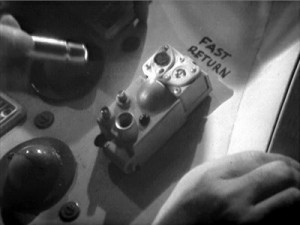 23. Seriously, the whole thing was caused by the fast return switch being jammed? No wonder he refused to use the thing again until the Paul McGann years. Oh, TARDIS. You and your complicated design and lack of an instruction book. Couldn’t you have stolen a smarter Time Lord? Or did you pick him based on the fact that he was going to get hot in a thousand years time?
23. Seriously, the whole thing was caused by the fast return switch being jammed? No wonder he refused to use the thing again until the Paul McGann years. Oh, TARDIS. You and your complicated design and lack of an instruction book. Couldn’t you have stolen a smarter Time Lord? Or did you pick him based on the fact that he was going to get hot in a thousand years time?
24. Still no apology, but the Doctor concedes that Barbara is the queen of everything. “Your instinct and intuition against my logic…” he suggests. No, mate, Barbara used logic as well as intuition. You just flailed. Put Barbara in charge and have a nap!
25. “We all owe you our lives,” he concedes Also not an apology.
26. “Because I accused you unjustly, you were determined to prove me wrong…” Oooh, look, trying to pretend that him being a dick was helpful to Barbara’s problem solving abilities.
27. “We must look after you, you know, you’re very valuable.” Never has a truer word been said, Doctor. Barbara is a keeper. Hang on to her.
There’s a sweet extended scene at the end, once they have landed “on a cold planet” in which the Doctor and Barbara have their making up chat, Susan and Barbara have a snowball fight, and the Doctor and Ian banter about Ian’s new coat. This is a new side to the TARDIS team, a coziness that would continue for the rest of the year until Susan finally grew up and left them in The Dalek Invasion of Earth. They’re more like a family now, and it only took a disturbing, abusive group breakdown to make that happen.
With scissors.
ELSEWHERE ON 1964
Sue Watches The Daleks [Wife in Space]
Sue Watches Marco Polo [Wife in Space]
November 18, 2012
What Geek Girls Wear (Is None of Your Business)
 Superheroes are hot right now. So hot, in fact, that some of the merch (occasionally) gets targeted at girls.
Superheroes are hot right now. So hot, in fact, that some of the merch (occasionally) gets targeted at girls.
When sparkly pink and black retro Batgirl, Supergirl and Wonder Woman t-shirts first turned up in the girls section of Target a couple of years ago, I bought them for my daughter Raeli because I thought they were awesome. Luckily, she agreed with me, and they came at the beginning of a long and fun (and occasionally frustrating) journey of discovering comic book heroes together.
For the next year, though, the only superhero t-shirts I found were “for boys” and though I grabbed a couple I thought she would like, she immediately recognised the dark blue and black code as not being “for her” and rejected them. (she has since got over this and I suspect still regrets the loss of the awesome plain black Batsymbol t-shirt that her younger sister wore as a dress for 3 years because it was enormous on her)
Nearly two years ago, when she turned six, Raeli had a superhero party. Most of the parents of boys had no problem digging out a costume or character for their child, while many of the parents of girls struggled to think of any. Anyway, a few girls came as superheroes, some came as princesses, most of the boys came as superheroes, one came as a dinosaur. Everyone had a great time and the important thing here is that I had an excuse to buy a Wonder Woman costume for my (then) six-year-old. I also like to think that a few kids came away from that party at least having learned that the Justice League looks great on icecream cake.
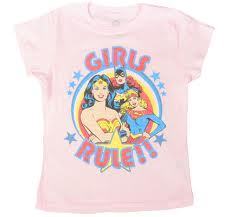 Superhero t-shirts and swimsuits and underwear and pyjamas have become a whole lot more prevalent over the last few years in Australia, as has a lot of other superhero merchandise, and even more of it (though still a small proportion) has filtered into the girls’ section. Polly Pocket was briefly both Supergirl and Wonder Woman. Fisher Price created a Batgirl to go with its many boy superhero characters. The DC and Marvel LEGO occasionally has sets including women, and Black Widow flies the Quinjet. More to the point, clothes, jewellery and accessories regularly turn up for the 8-12 girl range in particular, sporting girly superhero symbols.
Superhero t-shirts and swimsuits and underwear and pyjamas have become a whole lot more prevalent over the last few years in Australia, as has a lot of other superhero merchandise, and even more of it (though still a small proportion) has filtered into the girls’ section. Polly Pocket was briefly both Supergirl and Wonder Woman. Fisher Price created a Batgirl to go with its many boy superhero characters. The DC and Marvel LEGO occasionally has sets including women, and Black Widow flies the Quinjet. More to the point, clothes, jewellery and accessories regularly turn up for the 8-12 girl range in particular, sporting girly superhero symbols.
At Raeli’s gymnastics show last Saturday, I spotted several pink sparkly outfits with the Supergirl ‘S’ printed on them, sometimes in silver and glitter. I don’t think it’s unfair to assume that that most of the girls wearing those tops haven’t read Supergirl books/comics, or seen her in a cartoon, or anything, whereas a higher proportion of the boys who wore their Spider-Man or Iron Man costumes to the same gymnastics show probably have done.
This has nothing to do with me feeling all superior to the parents who haven’t introduced their daughters to superhero comics, and far more to do with the fact that Supergirl is DAMN HARD TO FIND outside the clothing racks. Apart from a few blink and you’ll miss it DC Shorts (which haven’t screened in Australia), we have to go back several years to a few animated episodes of Justice League Unlimited, or that Supergirl origin movie where the marketers were so afraid of turning off young male customers that they called it Superman/Batman: Apocalypse.
 Girls don’t get to have as many superheroes as boys. They don’t get as many shows, or movies, or toys that tell them they can save the world. They get some, and my Where the Wonder Women Are series has been about highlighting just how many interesting female superheroes are out there, but that doesn’t mean they are easily accessible for most 8-12 year old girls, the prime introducing-to-comics age, and the age at which most male comics fans discover a treasure trove of superhero wonder.
Girls don’t get to have as many superheroes as boys. They don’t get as many shows, or movies, or toys that tell them they can save the world. They get some, and my Where the Wonder Women Are series has been about highlighting just how many interesting female superheroes are out there, but that doesn’t mean they are easily accessible for most 8-12 year old girls, the prime introducing-to-comics age, and the age at which most male comics fans discover a treasure trove of superhero wonder.
It wouldn’t actually shock me if I discovered that the people who create those clothes are often just doing “the Superman S in pink” rather than specifically referencing a hero called Supergirl, much as the traditional boy shorts with skulls on them get reproduced as much shorter girly shorts with pink skulls on them. (I wish I was kidding).
For a lot of girls, the Supergirl t-shirt (or the Batgirl handbag or the Wonder Woman lipstick) is actually their first introduction to the idea that girls can be superheroes. And that’s okay. That’s actually awesome. I’ve talked before about how Raeli fell in love with Supergirl based on the picture on a drinking glass. Seriously, you don’t have to read Supergirl comics to get the concept. She’s like Superman, only she’s A GIRL.
 That’s an incredibly empowering idea to girls in the 8-12 age group who have emerged from only having Disney princesses or fairies marketed at them, and are on the verge of discovering High School Musical (yes, still, apparently), supermodels and popstars (they still call them popstars, right?). And even if it’s not empowering, even if they have no idea what the symbol means, it’s okay for them to wear the shirt. Maybe it will empower them later. Maybe it will make someone else smile when they see them walk by. Maybe it fits nicely and is in a flattering colour. All of these options are valid.
That’s an incredibly empowering idea to girls in the 8-12 age group who have emerged from only having Disney princesses or fairies marketed at them, and are on the verge of discovering High School Musical (yes, still, apparently), supermodels and popstars (they still call them popstars, right?). And even if it’s not empowering, even if they have no idea what the symbol means, it’s okay for them to wear the shirt. Maybe it will empower them later. Maybe it will make someone else smile when they see them walk by. Maybe it fits nicely and is in a flattering colour. All of these options are valid.
(Frankly in the case of many female superheroes, the concept behind the character can actually be a whole lot more empowering than the reality of the stories featuring that character.)
What I’m saying is, it’s okay to like the way a superhero looks or what she represents, and to wear clothing that reflects that. It’s equally okay to like the way that a superhero (or other geeky property) shirt looks and not have the faintest idea what it represents. Because frankly, as the mother of two superhero-loving daughters, it makes me smile to see a bunch of girls wearing totally mainstream pink Supersomeone t-shirts, because it means that my children are less likely to be ostracised or mocked for the stuff that they like.
Also, those shirts look cute.
Girls can even be superheroes on their hen’s night! Also men can hire dalek costumes for stag nights, but by all means let’s focus on what the WOMEN are wearing.
I’ve been thinking about all this because of the wave, the sheer weight of articles over the last couple of weeks talking about ‘fake geek girls’ and how scary prevalent that meme/trope/idea is, and the horrible treatment that women and girls all over the world, in “real life” and online, are receiving because of that idea. The insults, the scathing disdain and the icky, icky gender essentialism.While I have really appreciated the many critiques and discussions on this topic, and the number of smart people of both genders who have responded to this in interesting and thoughtful waves, what stuck in my head was a comment on one of those smart and articulate posts about how no, your experience and your opinion doesn’t matter, because *I personally* have met the fake geek girl and she’s everywhere. Here is my t-shirt related anecdote about a girl who didn’t know the full significance of a piece of clothing referencing a geek-associated property. Not actual quote there, but you get the idea.
And it seems to me that every time this topic is raised, someone or many someones (sadly not always male someones) is there with a t-shirt anecdote which apparently serves to justify the gross misrepresentation, personal abuse and in many cases workplace harassment that women suffer because a scary large number of “real geeks” feel entitled to be angry that women are enjoying fandom or fan-associated stuff in a SLIGHTLY DIFFERENT WAY. And yes this is just the same as other ‘I am more geeky than you, witness my obsessive superiority’ plumage displays that go on between (mostly) men in geekish, online and other communities, and yet it’s not just the same, because of the oppressive sexism and misogyny that turns these discussions and comments into something far, far more destructive and antagonistic.
The gender aspect of this discussion matters. It really, really does. Because what could be a mildly distasteful conversation about how annoying it is that our subculture has turned mainstream and a whole bunch of people who aren’t *that* into it are getting pleasure from it, and plus it’s really annoying how easy it is to buy t-shirts with our favourite geeky thing on it these days so we don’t get the thrill of the hunt… well, it pretends to be that conversation, but it’s not, because it turns into an exercise in “slut”-shaming and misogyny and “hot women only exist to torture us” so fast that it shames everyone by association. It’s embarrassing.
Because, of course, it’s not just about t-shirts. It’s also about young women who actually go to the time and effort of constructing a costume to wear a fannish event, only to be mocked, sneered at and bullied not only by “their fellow fans” but industry professionals such as Tony Harris. Really? They have to display their geek credentials BEYOND creating an entire costume to express themselves? Neil Gaiman certainly has something to say about that, and he’s not the only one.
Leaving aside the fact that most women who cosplay are actually OFFICIALLY PART OF GEEKDOM ALREADY, let’s just look at the hypothetical women who aren’t fannish and still wanted to cosplay. Why do it? Maybe they thought it would be fun, or a great challenge. Maybe they did it to join their friends, or in the hopes of making new friends. Shock horror, maybe they thought it might help them fit in, or to feel more part of the community? I’m going to go out on a limb and say that maybe some of them actually do want attention. That’s one of the many reasons people MAKE ART. Since when is it bad to want attention? Do fan artists or fanfic writers or actual professionals who have pride in their work beyond a paycheck, do none of them want their efforts appreciated?
I’ve linked to it before but it deserves it again: Courtney Stoker on cosplaying from a cosplayer perspective, and how it’s about art, fun and community, not boners. And this Bleeding Cool article (that reposts the Harris rant and his follow up rant which isn’t much better) addresses the story from a former judgy geekboy who learned to appreciate the different experience had in fandom by non-expert/newbie cosplayers by, um, having conversations with them and learning their perspective. I KNOW, RIGHT?
The idea that it’s okay to trash-talk women for expressing a geeky interest and maybe not being perfect at it yet is incredibly destructive, and yet sadly fits with a whole lot of other ‘accepted’ forms of sexism in our society. Creating unrealistic expectations of women and then punishing them when they fail to meet those expectations is, frankly, more mainstream than Star Wars and Batman ever will be. But that doesn’t mean that people in the geek community (sadly not just men) are not capable of doing it too.
Girls (and women) deserve to have superheroes, and TARDIS tutus, and even (yes, I’m gonna say it) Princess Leia slave bikinis if they want them. Especially if they go to the trouble of making them, though I am a fan of being able to get my geekery off the rack, personally. And the standard rule about not making gross public assertions about people based on what they look like or how they choose to dress? That one applies to geek activities too, because we all live in the world.
And of course I could have just linked to this awesome comic by Sailorswayze on Tumblr which sums up the whole double standard in a much shorter space, but then I wouldn’t have got to write about my daughter’s excellent sparkly superhero t-shirt collection.
Seriously, this is a great time for t-shirts.
November 16, 2012
Doctor Who Christmas Trailer! A touch of Female Gothic in this Victorian Christmas.
Tansythoughts under the cut.
General squeefulness from me, especially at the nod to Jenna Louise Coleman’s previous appearance in the introduction. They SO know something they are not telling. I am also really enjoying the ongoing relationship that “New Who” is developing between the Victorian era and particularly its Christmassy icons and the show. Plus, two of my favourite supporting aliens are back, FINALLY!
But mostly I love the little detail that “Clara” (if that IS her name, I trust nothing Mr Moffat) is a governess. Talk about embracing the traditions of Victorian literature. After all, the female Gothic can be summed up as ‘girl meets (tall, dark, handsome) house, which is possibly already inhabited by crazy/attractive strange man’ and what is that if not the current definition of Doctor Who?
NEW ERA! I’m excited.
EDIT:
Okay, the first time around I missed that there is a whole prequel Minisode AS WELL, packed with Madam Vastra, Jenny, and Strax. Hooray!
November 15, 2012
Friday Links Saved Absolutely No One
 This is my favourite thing on the internet this week: Diana Prince’s Diary, on Tumblr.
This is my favourite thing on the internet this week: Diana Prince’s Diary, on Tumblr.
Reported for duty in full pants as could not find star-spangled bottoms while tearing through apartment. Was written up by Batman (obviously) for N-52 Dress Code Violation and CCA-54 Intoxicated While On Duty. Placed on surveillance for next two weeks as punishment – v. bad.
And it just keeps getting better.
Even worse, sent text messages to ex-boyfriend and scoundrel Steve Trevor! Saved absolutely no one. Feel like total failure. Must endeavor to do better tomorrow.
I think my favourite bit is that in this reality, Steve Trevor might well be played by Hugh Grant, and Batman by Colin Firth.
What can I possibly follow that up with? Something even more self-indulgent, of course! The lovely David McDonald has reviewed my Creature Court trilogy and got so many things RIGHT about it (including thinking it’s great, obvioulys) that I just have to link to his review.
Jacqueline Rayner, my favourite writer who shares a name with me, is trying to raise awareness of Myalgic Encephalomyelitis (ME), and to that end managed to convince the excellent crew at Big Finish to create a Bernice Summerfield 20th birthday spectacular special audioplay as a fundraiser. She is currently running a competition over at her blog where you can win Many Happy Returns and a bunch of other Doctor Who/Merlin merch simply by educating yourself a little bit about the disease that not only devastates lives but is chronically misunderstood.
Or you can just run over to Big Finish and BUY Many Happy Returns (it’s around $15 for the digital download in Australian dollars, not sure about other currencies). All proceeds go directly to the charity Invest in M.E. as everyone involved – writers, actors, production crew – donated their time. Also it looks to be a hoot! More Bernice Summerfield is good for everyone.
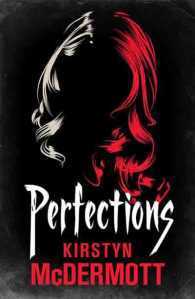 Kirstyn McDermott has revealed her cover for upcoming novel Perfections. Exciting! I am so looking forward to reading this.
Kirstyn McDermott has revealed her cover for upcoming novel Perfections. Exciting! I am so looking forward to reading this.
Someday, someone clever about the internet is going to have to show me how to set up a Storify, because they are AWESOMECAKES – basically a way of constructing a narrative from Twitter updates before they disappear into the aether. This one is about the response from many Indigenous Australians to Leader of the Opposition Tony Abbott’s comments about the need for more “authentic” Aboriginal people in Parliament. #itriedtobeauthenticbut contains some high quality snark and a whole lot of deserved sting about the experiences of young Indigenous Australians in our society.
There has actually been more than one blow up on the internet involving the massively offensive “girls who cosplay are fake geeks” meme, and intolerant asshats who seek to perpetuate that meme. Foz Meadows breaks down the important issues of the most recent outbreak of asshattery. And Courtney Stoker speaks on behalf of cosplayers everywhere when she says This Isn’t Attention Seeking, This is Fucking Art.
Peter M Ball talks about the aftermath of Genrecon. I’m so glad it didn’t break him. You never know, with con chairing…
The Mary Sue talks about how it looks like we are going to get some Gwyneth-in-armour action in the new Iron Man movie. I’m sold!
Amy Heckerling (of Clueless!) is interviewed about her new movie Vamps, which is a vampire comedy starring Alicia Silverstone, Krysten Ritter and Dan Stevens.
Thanks to Karen Healey for introducing me to the following fabulous fanvid about women who kick butt either metaphorically or literally!
November 13, 2012
Armageddon When?? [Xena Rewatch Interlude]
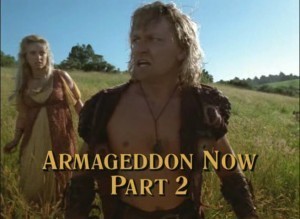 It’s been a while again! Apparently I don’t have the stamina to watch my way through all six seasons of Xena in one go. Before I move on to finish off the last disc of Season 3, though, there’s a crossover I need to discuss from Xena’s parent/brother show, Hercules the Legendary Journeys.
It’s been a while again! Apparently I don’t have the stamina to watch my way through all six seasons of Xena in one go. Before I move on to finish off the last disc of Season 3, though, there’s a crossover I need to discuss from Xena’s parent/brother show, Hercules the Legendary Journeys.
Hercules had got pretty awesome by its Season 4 (concurrent with Xena’s Season 3), moving away from dull monster-or-god-of-the-week stories to make the most of its adaptable, talented New Zealand cast and crew. Season 4 was when they really started having fun and experimenting with the format, not only in the outrageous comedy and musical episodes, but also with some audacious and epic drama. Yes, really, Hercules.
This was the season that gave us such classics as Stranger in a Strange World (evil universe of Evil bearded Dopplegangers), “…and Fancy Free,” (Hercules dances and acts out sexy Coke ads while Michael Hurst drops his usual role of Iolaus to play a credible and authentic pantomime dame), “Men In Pink” (Salmoneus and Autolycus do Some Like It Hot), and the ultra classic “Yes Virginia, There Is A Hercules” in which the regular cast play the modern day team of writers and producers. I can never see Liz Friedman’s name in a set of credits without remembering Hudson Leick’s psychotic performance as her, and as far as I’m concerned, the Roberto Orci and Alex Kurtzman who wrote the new Star Trek movie? Will always be Ted Raimi and Robert Trebor. Not to mention the disturbing mental image of Lucy Lawless being married to Bruce Campbell in a red wig…
But I digress!
Among the crazy, innovative and just plain fun wacky episodes, Season 4 of The Legendary Journeys also brought some high drama, and it’s to the show’s credit that it actually resolved the original Zeus-Hera-Hercules plot in a high stakes finale, leaving Hercules to move on with some epic reworking of Celtic and Mesopotamian mythologies in the next season, free of family baggage.
Before that, the show also produced a massive two part action spectacular which, like Surprise a year earlier, contributed so much to the Callisto arc (not to mention the Gabrielle-Hope storyline) that no Xena rewatch is complete without it.
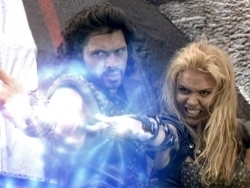 Which brings us to Armageddon Now, Parts 1 & 2.
Which brings us to Armageddon Now, Parts 1 & 2.
A funeral, and a corpse burning. Glittery particles swirl and eddy and form into a broken, charred body wrapped in a cloak. In between jolly scenes with Hercules, Iolaus, Herc’s mother and a drystone wall, the cloaked figure goes to the rockfall which took Callisto out of the equation not so long ago… and a cranky Callisto is released, by Hope.
For some reason, probably because she realises what show she has turned up in, Hope is ignoring the mother who murdered her and the hated figure of Xena, and has decided that Callisto’s new job is to go after “the greatest hero who ever lived.” Hercules, in other words.
Should Xena be offended?
The opening story is complicated, involving kings and Ares and plots of war, but as far as I’m concerned is an excuse to watch (yet again) the late and much-lamented Kevin Smith strutting his stuff against his hated brother. I love the fact that this excellent villain works completely differently in both shows, and yet is utterly consistent.
It’s also fun to see Ares working against (never with) his nephew and irritating leather-clad sidekick Strife, who I’m pretty sure never appeared on the other side of the pond in Xenaville. Callisto is always good value too. Hope is terribly dull but gives Callisto something to snark about.
Because, as it turns out, the story isn’t about Hercules or Ares or King Whatsits at all. It’s about Callisto, the angry self-hating goddess, who longs to end her own suffering, and the one thing that Hope can offer to tempt her with – a chance to change her own past.
DID I MENTION THIS WAS A CRACKED OUT TIME TRAVEL ADVENTURE? Possibly I should have done.
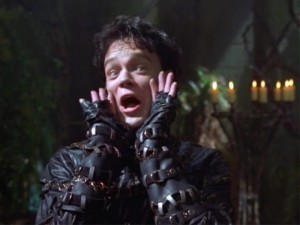 Things really kick off when Callisto turns up back in Ares’s life, and the two of them flirt shamelessly while taking turns to beat up the pitiful Strife. You’re never sure if they want to shag like bunnies or just cut bits off each other. Probably both, but it’s a highly entertaining dance which culminates in them both releasing another former villain out of his eternal prison – in this case the Sovereign, AKA Evil Hercules From the Universe of Evil Beards. Yes, he has an evil beard, just like Spock and yes, television was making meta jokes long before Community. But more importantly, the Sovereign has the McGuffin of the episode, a locket filled with blood of the Golden Hind (Herc’s second dead wife), the only thing that can kill a god.
Things really kick off when Callisto turns up back in Ares’s life, and the two of them flirt shamelessly while taking turns to beat up the pitiful Strife. You’re never sure if they want to shag like bunnies or just cut bits off each other. Probably both, but it’s a highly entertaining dance which culminates in them both releasing another former villain out of his eternal prison – in this case the Sovereign, AKA Evil Hercules From the Universe of Evil Beards. Yes, he has an evil beard, just like Spock and yes, television was making meta jokes long before Community. But more importantly, the Sovereign has the McGuffin of the episode, a locket filled with blood of the Golden Hind (Herc’s second dead wife), the only thing that can kill a god.
Which explains why the production team were so willing to let Callisto and Hope go visiting The Other Show – this script doesn’t require Hercules and Iolaus particularly, but wouldn’t make sense as a Xena episode because it requires so much Hercules-specific backstory.
IOLAUS: Hercules, he’s the same strength as you, this could take forever!
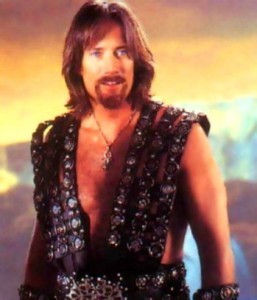 The Sovereign is not the amusing red herring that he appears to be. Instead, he’s an excuse to take Hercules entirely out of the action – this isn’t his story. Thanks to the unholy alliance between Ares and Callisto, both the Good and Evil Hercules are trapped in a dimension between worlds, unable to do anything but beat each other up in an endless loop, and watch the events unfolding in a conveniently tuned Television Pond.
The Sovereign is not the amusing red herring that he appears to be. Instead, he’s an excuse to take Hercules entirely out of the action – this isn’t his story. Thanks to the unholy alliance between Ares and Callisto, both the Good and Evil Hercules are trapped in a dimension between worlds, unable to do anything but beat each other up in an endless loop, and watch the events unfolding in a conveniently tuned Television Pond.
This leaves the stage clear for Iolaus and Callisto to carry the rest of the story, in which he is John Connor and she is the Terminator. No, wait. He’s Kyle Reese and she’s the Terminator. No, wait, he’s Sarah Connor…
Callisto and Ares have a bitchslap-and-punch-and-lighting fight to the not-death – he thinks it’s foreplay, she just wants the blood hanging in a locket around his neck. After beating Ares down (with some help from Hope), Callisto tries out her new toy, dipping her knife in the blood and killing Strife. It’s interesting that the death of a god is such a huge deal at this point in both the Xena and Hercverse – it’s going to be a major theme later! And it’s oddly touching how devastated Ares is to lose his useless lackey nephew. Strife is gone, and while they later bring the actor back in a similar role, the character is allowed to be dead.
It has to be something this big, for Ares and Iolaus to end up on the same side.
So Ares puts on his Big Boy Panties and decides reluctantly to be Original John Connor, sending Iolaus back in time to follow Callisto on her quest to change history Terminator-style.
 Luckily, Young “Herc’s Mum” Alcmene (okay, she’s the Sarah Connor) is already pregnant when Iolaus crashes into her life, because she’s kind of young and hot and given that I saw him checking out the older version of her earlier in the episode, he could so easily have ended up as Herc’s real Dad. I so hope that was in an early draft of the script. That would screw with everyone’s head, wouldn’t it?
Luckily, Young “Herc’s Mum” Alcmene (okay, she’s the Sarah Connor) is already pregnant when Iolaus crashes into her life, because she’s kind of young and hot and given that I saw him checking out the older version of her earlier in the episode, he could so easily have ended up as Herc’s real Dad. I so hope that was in an early draft of the script. That would screw with everyone’s head, wouldn’t it?
Callisto torments and hunts the young, pregnant Alcmene, while Iolaus tries to save her and by extension his unborn best friend. Of course, he ultimately fails, because Callisto is a goddess and a vengeful one at that.
This is where the story gets interesting – not because Hercules is now trapped forever in a bubble between worlds with his evil self, but because of where Callisto goes next: to claim her reward for destroying Hercules, she gets to visit Cirra, her home village, and the source of her childhood torment origin story.
 It’s the era of Evil Bad Hair Xena (there’s our girl!), who lays waste to the land, kicking arse and taking names, enabled by Soppy Young Ares.
It’s the era of Evil Bad Hair Xena (there’s our girl!), who lays waste to the land, kicking arse and taking names, enabled by Soppy Young Ares.
Xena’s army is about to attack Cirra, which we know to be the one time her soldiers did kill women and children, the war crime that made Callisto into the stone-cold monster she is today. Only, the first thing we see is Xena’s standing order to let the women and children live.
This is the first time we see Callisto vulnerable, as she tries desperately to save her family from the horrors she imagines Xena’s army will visit upon them. But all she knows is how to kill, and her vicious instincts lead her to kill her father by accident and then, once she has accepted the awful truth, her mother in “self-defence”. Turns out that she is the only reason that women and children were killed that day. Devastated, Callisto embraces her own unconscious teenage self and leaves her to die too.
That way, it will all be over.
But do-gooder Iolaus, who followed Callisto to this time in order to kill her, manages instead to save her younger self girl from a burning barn. The look on his face when he realises what he has done is one of those marvellous Michael Hurst moments – subtle and world-weary.
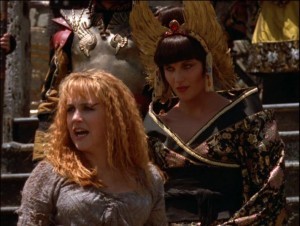 Then we have one more time jump into the “present day” – an alternate present where Hercules died in the womb and missed out on all his great heroic adventures. In case you’ve forgotten, one of the prime good deeds of Herc’s past was turning Xena good with his magical wang. This future therefore is ruled by Conquering Tyrant Xena, and also features Gabrielle as an angry revolutionary, plus a whole lot of hopeless misery.
Then we have one more time jump into the “present day” – an alternate present where Hercules died in the womb and missed out on all his great heroic adventures. In case you’ve forgotten, one of the prime good deeds of Herc’s past was turning Xena good with his magical wang. This future therefore is ruled by Conquering Tyrant Xena, and also features Gabrielle as an angry revolutionary, plus a whole lot of hopeless misery.
I don’t know why Gabrielle’s life as an angry, outspoken rebel involved a session of salon hair crimping. Best not to ask.
Oh, and the Ares of this reality is a rabid Empress Xena fanboy who has never heard of Iolaus, and is now no help whatsoever to his former ally. Luckily, Xena is unknowingly in the possession of a shiny time travelling doohickey, the Chronos Stone, yet another leftover from an old Hercules story.
LET’S DO THE TIME WARP AGAIN!
This time around, Iolaus saves Alcmene and fetus-Herc, and restores the timeline. Hercules manages to get home without bringing his beardy friend with him. And, oh by the way? Callisto is PISSED OFF at Iolaus.
But let’s not stop and stare at yet another brilliant fight scene – these episodes are full of those! The key thing is that Callisto claims she never went to Cirra – that timeline was closed off because Iolaus saved Alcmene. So that amazing moment of self-realisation in which she created her own future self… never happened. Hmm. Not sure if the story holds together if you’re going to do that. She should remember, surely? It’s a brilliant character development and makes later events so much more inevitable. Ah, well.
Two things are in vital places at the end of this story. Callisto has been chucked into the bubble universe with evil beardy Hercules. And Iolaus’ knife, the one he managed to daub with hind’s blood during one of Callisto’s more distracted moments, has been pushed into the stone outside Ares’ temple. No way that could turn out to be a really bad error of judgement…
Wait, I’ve got it now. Callisto is the Terminator, Iolaus is Kyle Reese, Hercules’ mother is Sarah Connor and… Xena is SKYNET!
Join me next time for the last disc of Xena season 3, and the final piece of the Callisto pie.
Previous Xena Rewatch Posts:
Warlord is a Lady Tonight
I Don’t Work For Money
Amazon Wanna Take A Ride?
Go To Tartarus!
Swashbuckle and Shams
Death In A Chainmail Bikini
Full Moon It Must Be Xena
How Do You Mortals Get From Day to Day?
The Future is Archaeologists
Divide and Conquer
My Sword is Always Ready to Pleasure You
Hide the Hestian Virgins!
Lunatic with Lethal Combat Skills
Coping with Your First Kill
Sweet Hestia, I’m In a Den of Filth
The Bitter and Sweet of It
Because Caesar Was Taken
Release the Chicks!
Chicks Unravel Time is officially released! I am delighted to be part of such an awesome project. There’s nothing quite like being invited to be part of a book you would walk over broken glass to read.
You can check out a teaser for my Colin Baker & Peri essay, “The Ultimate Sixth,” over on Doctor Her, along with a teaser for my fellow contributor Courtney’s essay about Martha Jones.
One of my editors, L.M. Myles, has posted some excited updates about the book and some of its promotional activities.
Reviews from the Examiner and SFX.
Get your copy now for a fabulous collection of smart essays about Doctor Who’s various eras, by many smart women writers!
November 12, 2012
The Mystery of the Unearthly Teenager [WHO-50—1963]
 Yep, I’m blogging about something for every year of Doctor Who, once a week, as a countdown towards the 50th anniversary next year. Even those years when there’s no Doctor Who to speak of. I do like a challenge…
Yep, I’m blogging about something for every year of Doctor Who, once a week, as a countdown towards the 50th anniversary next year. Even those years when there’s no Doctor Who to speak of. I do like a challenge…
“An Unearthly Child,” the first episode of Doctor Who, screened on 23 November 1963 and has always been considered something of an odd duck. It’s not like any other story that would follow over the next couple of years, doesn’t quite fit with the other three episodes that are considered part of the same “story” (and not only because even the most committed fans are usually tempted to skip past the embarrassing cavemen of episodes 2, 3 & 4 and go straight to the Daleks).
On rewatching, this first episode is as strange and compelling as I remembered. The mist and fog gives the London streets a sinister atmosphere, and even the ordinary sets such as the classrooms take on a surreal and otherworldly aspect in the little vignette flashbacks that build up the Mystery of Susan Foreman.
It’s all so domestic, the tale of the two teachers investigating a problem student, and despite the Twilight Zoney mood of the piece, you can believe right up to the last ten minutes that it’s going to continue on as a TV show set purely in 1963 London.
But how much information do we actually get about the show’s mythology, the Doctor himself, and particularly the character of Susan, who remains partly shrouded in mystery even to this day?
Susan, the Doctor’s granddaughter, is probably the most important element of the show’s mythology that has not yet been mined by New Who. There have been a few hints here and there – “I was a Dad” and so on, and fans were briefly tantalised by that mysterious lady in The End of Time in the hopes that she might, might be one of the two Time Lord women we actually care about (she wasn’t).
We may never get more Susan in the show – and my wistful hopes of an Eleven-and-River-leave-a-baby-basket-on-One’s-doorstep story are probably going to be fruitless. But if she was going to show up again, the 50th anniversary of her first appearance would be a really good time to do it, just saying!
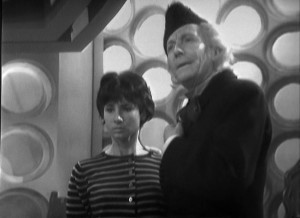 SO WHAT DO WE LEARN ABOUT SUSAN, THE DOCTOR AND OUR NEW FAVOURITE TV SHOW IN “AN UNEARTHLY CHILD”?
SO WHAT DO WE LEARN ABOUT SUSAN, THE DOCTOR AND OUR NEW FAVOURITE TV SHOW IN “AN UNEARTHLY CHILD”?
For a start, the TARDIS. I mean, the police box, in the junk yard. It’s important. It has to be important, because it’s humming, and the camera is getting all excited about this close up shot, so early in the first scene. If the police box is not important, this is bizarre camerawork!
Susan is a scientific genius. Ian Chesterton, her science teacher, acknowledges her as such, and also that she “lets her knowledge out a bit of a time so as not to embarrass me.”
Also, Susan’s grandfather doesn’t like strangers. This seems to be one of the greatest understatements of the episode, though it’s also one of those facts that won’t always hold true.
Susan is a fan of contemporary music, especially John Smith and the Common Men. Until about a fortnight ago, I always thought this was a real band and am a little saddened to learn that’s not the case (damn you, Wikipedia). Alarming that Ian knew so much about them, considering that Susan blatantly made them up. Trying too hard to be ‘with it,’ Mr Chesterton? Best stick to the Beatles. The line about how ‘John Smith’ is a stage name for a peer called Aubrey Waits sounds like a clever foreshadowing of the way that the Doctor would regularly use John Smith as a pseudonym in later years, but probably isn’t.
Susan reads fast – she claims that she would easily be finished with Barbara Wright’s massive tome on The French Revolution the next day. Then again, the teens in 1963 didn’t have the internet or texting, so chances were it wasn’t that major an achievement to finish a book overnight. Especially when Susan seemed mainly to want to flip it open to random pages and argue with it.
She likes walking through the dark, because “it’s mysterious.” This is in direct contradiction to her nervous disposition as conveyed in Episode 2, when she has a major panic attack upon realising her Grandfather hasn’t been on screen for two minutes, but then again, this is the 20th century, and it’s pretty clear that she has got deeply attached to this particular time and place. A placid, slightly emo geek girl.
As they kill time in the car between the “appropriate concern for a student” scene (at the school) and the “inappropriate concern for a student” scene (following her home, manhandling her grandfather, entering her domicile without permission) history teacher Barbara and science teacher Ian reveal all manner of intelligence they have gathered on Susan, mostly revolving around the odd juxtaposition of what she knows (“these simple experiments are child’s play to her”) and what she doesn’t know (that Britain is yet to go on to the decimal system)
Ian sums her up as “A fifteen year old girl who is brilliant at some things and excruciatingly bad at others.”
But that scene with the car chat and all the flashbacks reveals one other key fact: Susan’s experience with and knowledge about Time and Space as the fourth and fifth dimensions. Nonsense, thinks Ian. But Barbara is not so sure… (Barbara, you might as well know now, is the smart one)
Not related to Susan at all but can I just say the music in this episode is uncanny – it sounds so similar to the kind of music being used more than a decade later in Pertwee and Baker stories! Especially the oboe.
Now we get down to the good stuff: Susan and her mysterious grandfather (who is a doctor, you know) turn out to live in that humming police box we saw back in the opening shot of the episode. And, after Ian has carefully walked around said police box, we discover that it is bigger on the inside than the outside!
NO.
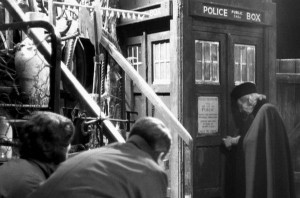 In fact it contains an enormous, white room with a strange console in the middle (okay the word ‘console’ wasn’t in common use in the show until decades later but I’m a child of the ‘everything in the wrong order’ VHS age, so shut up). A much bigger console room, it has to be said, than we get at any other time in the show’s history until the 1996 TV Movie. It’s massive. No wonder Peter Cushing’s version was portrayed as a garden shed. You could grow a LOT of tomatoes in this greenhouse.
In fact it contains an enormous, white room with a strange console in the middle (okay the word ‘console’ wasn’t in common use in the show until decades later but I’m a child of the ‘everything in the wrong order’ VHS age, so shut up). A much bigger console room, it has to be said, than we get at any other time in the show’s history until the 1996 TV Movie. It’s massive. No wonder Peter Cushing’s version was portrayed as a garden shed. You could grow a LOT of tomatoes in this greenhouse.
The Doctor himself actually gives a speech, right here in episode one in 1963, on why exactly the TARDIS is bigger on the inside than the outside, using television as a metaphor: ‘By showing an enormous building on your television screen you can do what seemed impossible.’ It’s nonsense, of course, but delivered with such élan and credibility… which is at its heart exactly what Doctor Who is all about: credible nonsense.
The bit which is perhaps most at odds with what we later came to know about the show’s mythology is Susan’s claim here that she made up the name ‘TARDIS’ from the initials ‘Time and Relative Dimensions in Space.’ It’s not impossible, of course, time travel being what it is, that she was around for the creation of the early TARDISes, but it does mean that it’s hard to accept the easiest possible explanation for her origins.
OR DOES IT?
The patriarchal and patronising aspect of the Doctor, which exists across all versions of his character to a greater or lesser degree, is most definitely in evidence here. He compares Ian and Barbara’s intelligence to that of “savages,” while Ian complains he is treating them “like children.”
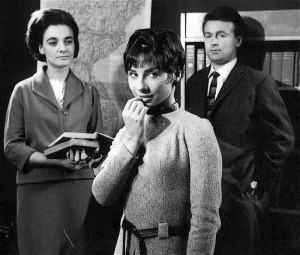 Both Susan and her Grandfather are aliens. “I was born in another time, another world,” she claims, while he asks the quite bewildering rhetorical question, “Have you ever wondered what it would be like to be wanderers in the fourth dimension? Exiles. Aliens.”
Both Susan and her Grandfather are aliens. “I was born in another time, another world,” she claims, while he asks the quite bewildering rhetorical question, “Have you ever wondered what it would be like to be wanderers in the fourth dimension? Exiles. Aliens.”
The tiny piece of Susan’s story which I see talked about least is the fact that, at this point in time, she has quit that life of wandering in the fourth dimension. She so attached to the 20th century that she yells she would rather leave the TARDIS and her Grandfather. She’s done with him, but he is not yet willing to let her go.
I’m not sure if this makes it better or worse that he later abandons her in the war-ravaged 26th century the second she shows interest in a boy, but it’s worth considering. Susan is desperate to stay in this one time and place, and the Doctor is desperate not to let go of her. Kidnapping Barbara and Ian is, apparently, his last ditch chance to keep his family together.
Oh, and the weird visual effect we see in the opening and closing credits is actually the time vortex. So, that too.
Wow, it’s amazing how much they packed that episode! So much mythology hitting the viewers all at once, and yet – nothing has been explained. That’s what the next fifty years is for, after all.
It even took until Episode 2, the Cave of Skulls, for us to learn that the TARDIS isn’t always a police box – it changes with every trip (“It’s been an Ionic column, and a sedan chair…”) but is now unaccountably broken. I blame Ian and his random button-pressing. Episode 2 also provides our first and second take on the “Doctor Who?” gag that justifies (apparently) the show’s title. Everyone groans at it in New Who, but you know what? Until they started doing that, I had never noticed it before in Classic Who. Now I see it everywhere.
Episode 2 is worth seeing, posh beardy cavemen aside, because it shows how much faster Barbara the history teacher is adapting to their whirlwind adventure than is Ian, the science teacher. Baffled by the sight of prehistoric Earth, he gasps, ‘there must be some explanation’ and she responds by giving him him such a withering look which to me translates as: ‘Dude we had the explanation ten minutes ago, keep up!’
Susan may be the mystery that launched the show back in 1963, but Barbara is the one already proving what is required for a good Doctor Who companion. Think fast, adapt to sudden changes in the environment and for heaven’s sake, KEEP UP.
The Creators of Doctor Who Were a Scandal
[i09]
Interview with Waris Hussein, first director of Doctor Who
[Radio Free Skaro]
Let’s Talk About Verity
[Doctor Her]
The First Doctor of Christmas
[Tor.com]
A Modern Woman’s Guide To Doctor Who: The First Doctor Years
[TansyRR.com]
An Unearthly Child
[Wife in Space]
An Unearthly Child
[Chronic Hysteresis]
An Unearthly Child
[Kasterborous]
Review of An Unearthly Child
[The Independent]
Original Radio Times Announcement for An Unearthly Child
[BBC Archive]
November 11, 2012
Another Weekend Flashes By
“Do we lose Bechdel points if we wrestle right now?”
November is kicking my arse.So glad I didn’t try to sign up for NaNoWriMo or any other writing commitment (though I have a bunch of commitments still hovering meaningfully around my head) because the combination of work outside the house and my trip away means that I am behind on everything, simply everything, and every day seems to put me further behind.
The house is a mess, my stress levels are through the roof, and ever since Genrecon my brain has been screaming at me to get a real job, which is frankly unproductive.
On the bright side, we watched Flash Gordon on Blu-Ray with a horde of children on Friday night, and even though their ages range from 3-9, it was the perfect timing for ALL of them. We cynical adults were quite taken aback with the sheer joy and devotion to which our children glommed on to this movie. I mean, what are the odds that the thing we love ironically because of Brian Blessed wearing leather shorts and wings, or Timothy Dalton dressed as Robin Hood, would also appeal to little fairy-and-princess obsessed Jem AND the Captain-America-obsessed Felix?
FLASH! Ah-ahhh. I do love that music, even if Queen slacked off and only wrote about six bars for the whole movie.
 There was a bit of adulty not-appropriate-for-kids stuff in it, but surprisingly little. The sexism was ingrained to the point of hilarity, right up to the point where Princess Aura was whipped, and all the adults in the room went – ohhh, crap just stopped being funny. The children didn’t seem to notice. There was also a gross bit where one of the bad guys was impaled on spikes and his eye bulged out, and while we were all busily trying to cover the eyes of the little ones, the elder ones thought this was the BEST THING EVER and promptly started re-enacting it. So that’s gonna be a fun school playground this lunchtime.
There was a bit of adulty not-appropriate-for-kids stuff in it, but surprisingly little. The sexism was ingrained to the point of hilarity, right up to the point where Princess Aura was whipped, and all the adults in the room went – ohhh, crap just stopped being funny. The children didn’t seem to notice. There was also a gross bit where one of the bad guys was impaled on spikes and his eye bulged out, and while we were all busily trying to cover the eyes of the little ones, the elder ones thought this was the BEST THING EVER and promptly started re-enacting it. So that’s gonna be a fun school playground this lunchtime.
I was amused to noted that despite its general glorious awfulness, the movie does pass the Bechdel Test. And while the movie is wall to wall slave women, and Princess Aura’s costumes defy gravity and all laws of taste, it’s kind of hard to argue that Flash Gordon’s treatment of women is worse than say, Star Wars. What with there at least being two female main characters, a female beta-villain (we mentally recast her as Michelle Pfieffer in the inevitable Tim Burton remake) and a world that would actually be able to repopulate itself in a reasonable manner.
 Also, Dale Arden is a freaking superhero. For at least ten minutes of the movie. In high heels.
Also, Dale Arden is a freaking superhero. For at least ten minutes of the movie. In high heels.
As part of my post-Genrecon wave of Do The Internet/Career/Business Better, I have decided to bite the bullet and experiment with affiliate links on my blog. I’ve always been resistant to ads in the past, but given that so much of what I write ends up inspiring people to make massive book/DVD purchases anyway, I might as well make it official. Still tinkering, as I don’t want to make my pages ugly or the links/ads to be invasive. So mostly I’m putting them underneath the big, substantial pop culture essays. I’ve signed up for a few different programs, all online book sellers that I actually use myself, but so far I am skewing towards those which are the easiest & prettiest.
It’s all so hard! I want to use a variety of sellers because everyone wants to use whatever their favourite is, but I can’t see how using more than a couple is going to be remotely possible because it will get messy. Also some affiliates make producing pretty banners/visual ads super easy and others are very hard to navigate. Still, the experiments continue.
You can see an example of the kind of affiliate links I’m setting up here on the Batgirl essay or my Susan Death essay if you’re interested. Happy to take feedback or suggestions from anyone who has Opinions on how the links look, or anything else to do with this because new! and hard! I hope it doesn’t have a negative effect on any regular readers of my blog, or annoy people.
The good news is that if I do make even a small amount of income from these links, I will officially lose all guilt about the amount of time I devote to writing long and complicated blog entries instead of actual novels. So, there’s that! And of course anything that makes it easier for people to get hold of my own books has to be a positive thing for me as a writer.
Speaking of blogging, keep an eye out tomorrow for the new blog essay series I am launching, Who-50, in which I will be writing SOMETHING about every year of Doctor Who between now and the big anniversary in November 2013. Yes, that means that tomorrow is 1963!
November 9, 2012
Where the Wonder Women Are: #28 Doctor Light
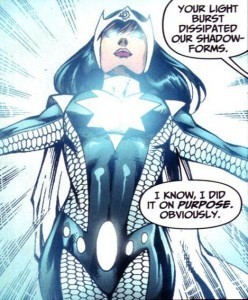 Dr Light is a second rate villain, and a first class heroine. Funnily enough, I prefer the latter version.
Dr Light is a second rate villain, and a first class heroine. Funnily enough, I prefer the latter version.
Kimiyo Hoshi, AKA Dr Light, a Japanese astronomer, scientist, medical doctor and mother, was introduced in the original 1985-6 Crisis storyline. Struck by an immense wave of power sent to Earth by the Anti-Monitor, she received the powers of “photonics” and could bend and manipulate light with her mind.
She became an occasional member of the Justice League in the late 80’s, dropping in for occasional missions, but joined them full time after Justice League Europe moved to London, eventually taking on greater responsibilities with the UN as Justice League International. She also changed her costume from all white to all yellow, which might seem like a trivial detail, but marks the point at which she became a fully fledged character.
Kimiyo can use her photonics powers to create hard light illusions and to fly, but for the most part uses them to blast shit up. She also serves as the token ‘scientist’ on the team, which means of course that she has a passing knowledge/full blown expertise in anything remotely technical that is required for the plot, including teleport systems, computers, biology, electronics, medicine/surgery and, well, you get the general idea.
 Originally written as a hard-edged, uncompromising career astronomer, Kimiyo went through a personal journey (originally inspired by the death of Supergirl, though the erasure of that character meant that her motives were vaguer in later stories) in which she tried to be a nicer and less selfish person. This was certainly the case when she was re-introduced into the Justice League, as her personality was far gentler and prone to hesitation. It didn’t help that she was portrayed at times through the Justice League Europe days as hanging back, or playing with her hair. This was actually pointed out to her on more than one occasion in the narrative.
Originally written as a hard-edged, uncompromising career astronomer, Kimiyo went through a personal journey (originally inspired by the death of Supergirl, though the erasure of that character meant that her motives were vaguer in later stories) in which she tried to be a nicer and less selfish person. This was certainly the case when she was re-introduced into the Justice League, as her personality was far gentler and prone to hesitation. It didn’t help that she was portrayed at times through the Justice League Europe days as hanging back, or playing with her hair. This was actually pointed out to her on more than one occasion in the narrative.
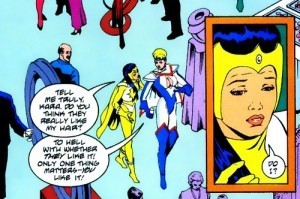 At one point during Justice League International Kimi suggested to Power Girl (whose aggressive persona was suddenly being acknowledged in the narrative as something to be worried about) that her own previously “bitchy” persona may have been caused by food additives and suggested that Kara too consider laying off the artificial sweeteners. YES THIS IS A CONVERSATION THAT HAPPENED IN COMICS.
At one point during Justice League International Kimi suggested to Power Girl (whose aggressive persona was suddenly being acknowledged in the narrative as something to be worried about) that her own previously “bitchy” persona may have been caused by food additives and suggested that Kara too consider laying off the artificial sweeteners. YES THIS IS A CONVERSATION THAT HAPPENED IN COMICS.
Most of all what I remember of Kimiyo in her Justice League days is the role she played as friend and teammate. She developed a sweet friendship with Wally West’s Flash (he gave her the nickname ‘Keychain’ after she told him her nickname in Japanese would be Ki-chan) as well as with the women of the group, and was particularly maternal with Maya, the thirteen-year-old Indian superheroine who fled her family to find sanctuary with the Justice League.
Speaking of maternity, Kimiyo was a mother of two children whom she had left in the care of her own mother back in Japan, and featured/were referenced in Justice League stories far less often than the kids of Rocket Red or Animal Man. I only remember one actual appearance of the kids, in a Justice League Quarterly one-shot about a budding romance between Kimiyo and the Global Guardian Rising Sun.
 But Kimiyo wasn’t just the nurturing tech support of the team. She began to take on more and more of a leadership role, as the JLI’s technical and admin support drifted away from the comic with the absence of Catherine Cobert and then Sue Dibny. They had gone through a couple of ‘headline act’ leaders in the team in this era, notably Aquaman and Green Lantern (Hal Jordan), but both suffered from the old problem of mixed loyalties, and when Hal’s responsibilities and dramas in his own title (incluidng Becoming Evil) took him away from the team one last time, Doctor Light stepped up to do his job.
But Kimiyo wasn’t just the nurturing tech support of the team. She began to take on more and more of a leadership role, as the JLI’s technical and admin support drifted away from the comic with the absence of Catherine Cobert and then Sue Dibny. They had gone through a couple of ‘headline act’ leaders in the team in this era, notably Aquaman and Green Lantern (Hal Jordan), but both suffered from the old problem of mixed loyalties, and when Hal’s responsibilities and dramas in his own title (incluidng Becoming Evil) took him away from the team one last time, Doctor Light stepped up to do his job.
As the new Justice League International, the team took on serious roles as ambassadors of peace and general goodwill, and there was a substantial storyline about them travelling a great deal, split up across various embassies, representing the UN. At the same time, Kimiyo developed an odd friendship with a disembodied spirit she called Erewhon, who could only speak to her by possessing various bodies. He made it clear that he was in love with her, but she never said anything about whether or not she reciprocated – she did, however, use her work in hard light to create something of a body for him, so that he could communicate if not enjoy any actual human senses.
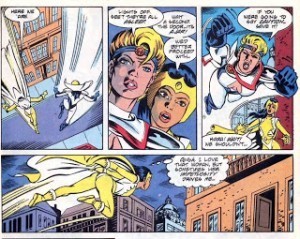 All of these storylines – Maya’s development, Kimiyo’s work on Erewhon, Power Girl’s mood swings and unexpected mystical pregnancy (yes, really), as well as a whole lot of intergalactic soap opera, came to a crashing halt when the JLI was swept between two major DC crossover events which had little to do with the development of their characters.
All of these storylines – Maya’s development, Kimiyo’s work on Erewhon, Power Girl’s mood swings and unexpected mystical pregnancy (yes, really), as well as a whole lot of intergalactic soap opera, came to a crashing halt when the JLI was swept between two major DC crossover events which had little to do with the development of their characters.
In Judgement Day, all of the Justice League teams joined forces to fight the Overmaster, and a leadership rift between the aggressive Captain Atom, and the ‘let’s talk strategy instead of rushing off with guns like an idiot’ Wonder Woman, Kimiyo didn’t even consider putting in her own claim to leadership. Instead she sided with Captain Atom first, as part of her character arc of trying to be more active instead of passive, though she told him to his face she thought Wonder Woman was the more intelligent leader.
After the dust cleared, and the teams mourned the death of their sweet friend Ice as well as many other emotional dramas, Captain Atom and Wonder Woman started politicking to form their own teams. While several JLI members such as Crimson Fox and Metamorpho picked a side, others like the Flash went off on their own.
Issue 67 of Justice League International (August 1994) was not the final issue of the run, but it was the last from their creative team at the time, including writer Gerard Jones, and felt very much like a hasty finale for the series, as Issue 68 was mostly an introduction to the next big DC Event, Zero Hour.
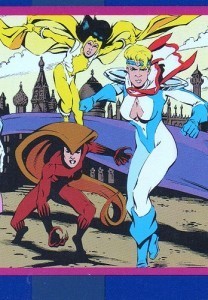 Kimiyo, Maya and Kara were reluctant to lose each other, but all had family reasons to leave the League. Maya’s family had returned to make amends for how they had failed her in the past and while Kimiyo was angry about at first she eventually listened to Maya and supported the teenager’s choice to give them another chance. This, combined with Kara’s fears of her pregnancy, also made Kimiyo suddenly remember her own children, abandoned for so long. Her friendship with Maya showed her that she could be a mother as well as have a career, and that if she was going to sacrifice an element of her life, maybe this time it could be the superheroing. (she wasn’t going home just to be with her children, but also referred to getting a research job)
Kimiyo, Maya and Kara were reluctant to lose each other, but all had family reasons to leave the League. Maya’s family had returned to make amends for how they had failed her in the past and while Kimiyo was angry about at first she eventually listened to Maya and supported the teenager’s choice to give them another chance. This, combined with Kara’s fears of her pregnancy, also made Kimiyo suddenly remember her own children, abandoned for so long. Her friendship with Maya showed her that she could be a mother as well as have a career, and that if she was going to sacrifice an element of her life, maybe this time it could be the superheroing. (she wasn’t going home just to be with her children, but also referred to getting a research job)
There was also a throwaway line about her planning to fix Erewhon, who had been damaged and rendered inert in recent events. His plot line was never resolved beyond this.
A final showdown with the representatives of the UN, including their friends Maxwell Lord and Catherine Cobert, was emotionally painful but it was very clear that the financial support was gone and any Justice League that remained would be independent. Kimiyo, Kara and Maya chose to leave, and even a final battle at Wonder Woman’s side and the revelation that they were deeply (finally) appreciated by the ordinary people on the street, was not enough to make them stay.
Which would actually have been a pretty awesome note to end on. But of course, this is comics, and no one gets a forever happy ending.
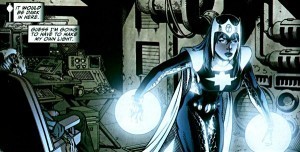 Over the last decade or more, Doctor Light has turned up every now and then for group events, and even briefly ran a version of the Justice League herself. Her powers (and memory) were completely drained at one point in the Infinite Crisis storyline by Arthur Light (remember I said there was also a Doctor Light who was a second rate villain? That guy. Don’t even talk to me about that guy) though she later reappeared as if this had never happened.
Over the last decade or more, Doctor Light has turned up every now and then for group events, and even briefly ran a version of the Justice League herself. Her powers (and memory) were completely drained at one point in the Infinite Crisis storyline by Arthur Light (remember I said there was also a Doctor Light who was a second rate villain? That guy. Don’t even talk to me about that guy) though she later reappeared as if this had never happened.
She has been seen working for S.T.A.R. Labs in Metropolis, and working as a business executive in Star City, as well as briefly flirting with inclusion in the Birds of Prey. Ah, Kimiyo and your elastic credentials, you will never be out of work. She also occasionally has remembered her children and retired from superheroing more than once to go back to them, whenever a writer wants her out of the way.
I often wondered how those kids of hers turned out. Unfortunately, this is comics, so kids don’t get to grow up. Otherwise we would have known by now which of them ended up a super villain, and which one inherited her mother’s skills at ALL THE SCIENCE.
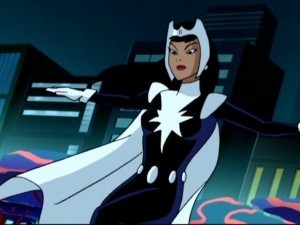 But what about the New 52? Kimiyo was not included in the more recent version of Justice League International (for which fans of the character should be supremely grateful), and as far as I can gather, she doesn’t seem to have appeared in the new continuity. Someone tell me if I’m wrong! She did appear in the Justice League Unlimited cartoon, and apparently is also appearing in Young Justice.
But what about the New 52? Kimiyo was not included in the more recent version of Justice League International (for which fans of the character should be supremely grateful), and as far as I can gather, she doesn’t seem to have appeared in the new continuity. Someone tell me if I’m wrong! She did appear in the Justice League Unlimited cartoon, and apparently is also appearing in Young Justice.
Considering that DC have been making at least grudging attempts to support diversity in their comics, and that Kimiyo Hoshi is indeed the most readily employable character you can imagine, it’s a shame that such a useful character hasn’t been given a place in the new DCU, in print anyway. Maybe Birds of Prey could use her, now they don’t have Oracle’s techy smarts to call upon? HAS ALL THE SCIENCE, WILL TRAVEL.
Where the Wonder Women Are:
0: Introduction
1: Black Canary
2: Rogue
3: Hawkgirl/Hawkwoman
4: Black Widow
5: Wonder Girl
6: Captain Marvel
7: Vixen
8: Abigail Brand
9. Jubilee
10. Batwoman
11. Catwoman
12. Huntress
13. Robin
14. Batgirl
15. Jean Grey
16. Ice
17. Emma Frost
18. Fire
19. Lady Sif
20. Supergirl
21. The Wasp
22. Gypsy
23. Misty Knight (and Colleen Wing)
24. Mystek
25. Kitty Pryde
26. Crimson Fox
27. The Invisible Woman
November 8, 2012
Friday Links Unbattens the Hatches
 Okay, so apparently it’s tornado season in Hobart. Who knew? Please, no one tell my daughter that we apparently get tornadoes here now. She has a hard enough time dealing with thunderstorms. And snails.
Okay, so apparently it’s tornado season in Hobart. Who knew? Please, no one tell my daughter that we apparently get tornadoes here now. She has a hard enough time dealing with thunderstorms. And snails.
As we batten our hatches for a night of horrible weather, never let it be said that I don’t provide entertainment! According to Sarah Wendell of Smart Bitches, Trashy Books, who gave a great presentation at Genrecon on social media, the afternoons are the prime time for workers to be screwing around on the Internet. I feel very guilty for not enabling my Australian readers sufficiently because I’m late again!
EDIT: Spoke too soon about the weather, we’ve had our tornadoes and thunder & all is peaceful again. Aww, Hobart, you do love screwing with our heads.
The spectacular Narrelle M Harris emptied her brain beautifully into this blog post about halfway through Genrecon, and managed to capture a lot of things that I had forgotten to impart to others. *pats Narrelle’s brain*
After three years, the Australian Government has finally dropped their ridiculous plan to filter the entire Internet. One less thing for us to be embarrassed about our Government!
i09 talked about how fans can be responsible for destroying the franchise they love.
Blue Milk addresses the fascinating question of whether Australia is more feminist than the UK.
Random Alex reviews a biography of Emmeline Pankhurst and talks about the incredible history of the suffragettes.
 Judy Chicago talks about her massively important art installation from the 70′s, The Dinner Party (I studied this at college and it blew my mind) and the reactions to it at the time & over the years.
Judy Chicago talks about her massively important art installation from the 70′s, The Dinner Party (I studied this at college and it blew my mind) and the reactions to it at the time & over the years.
Kameron Hurley talks about her favourite bit of new release Rapture.
I’ve really been enjoying the Bitch Magazine series on what can be learned about marriage, babies, abortion and the realities of fertility from the TV series Call the Midwife. The last entry, What Republicans Can Learn About Marriage From Call The Midwife, is spot on as always. Definitely something worth bookmarking for when people start reminiscing about ‘the good old days’.
Kaaron Warren is ‘Refreshing the Well’ over at her blog every day, which would be worth checking in on if you are a writer feeling a bit dry for inspiration. Nano-ites, run don’t walk!
A steampunk knitting book. If only I could knit something more complicated than squares!
Wonder Woman in an invisible mecha suit. Your argument is invalid.

